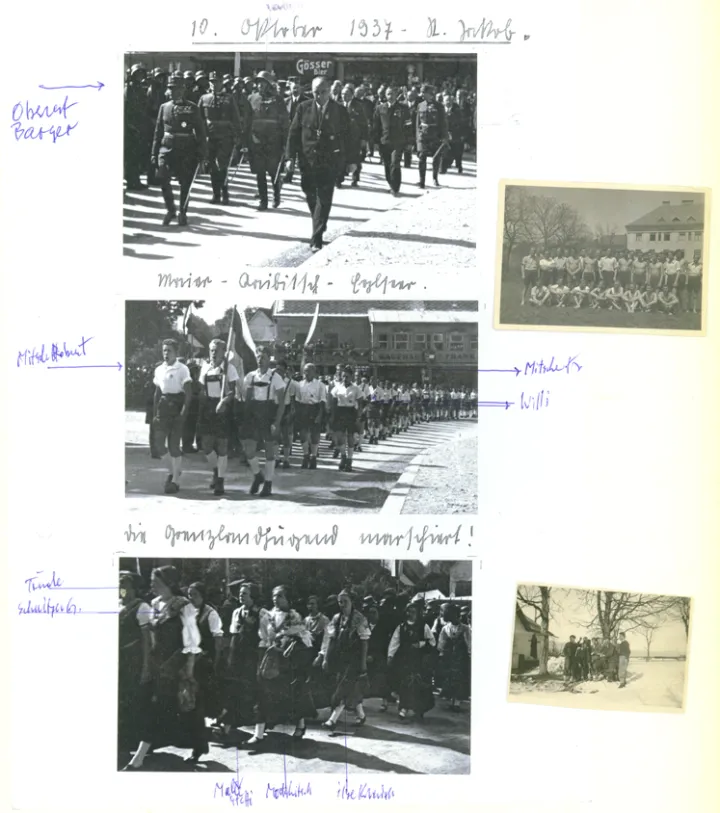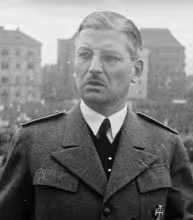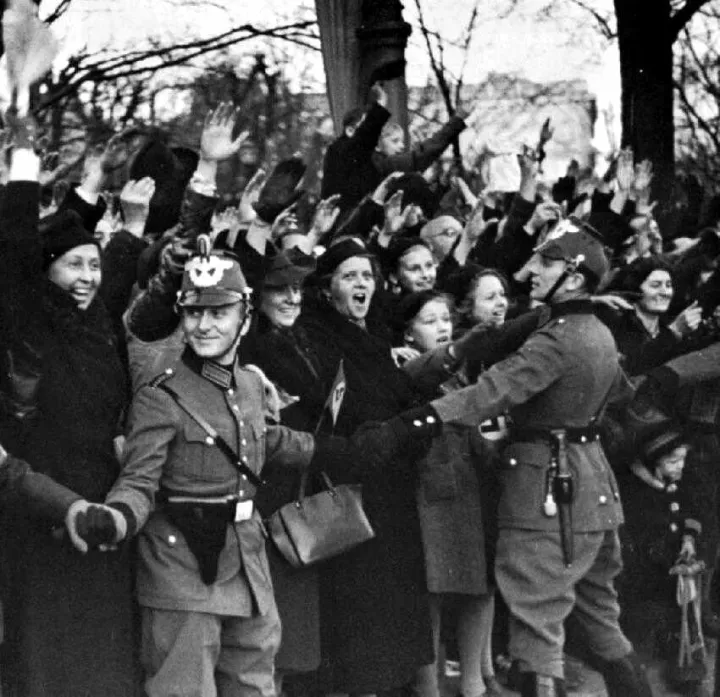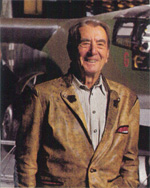Marching Conquerors – or Flags and Flowers?
March 12th-15th, 1938 Feistritz i.R. – Klagenfurt
by Wilhelm L. Kriessmann, 2008
copyright Carolyn Yeager 2013
It started early with me as with quite a few young Gymnasiasts at the Bundesgymnasium (state high school) in Klagenfurt. In 1932, when I entered the boarding school, I joined the National Socialist Schuelerbund and never left the ranks of “Gross Deutscher Gesinnung” (idea of Greater Germany). Was it because of the influences in my home village where my schoolteacher father struggled to keep the German language predominant in the school against the local priest’s Slovenian? Was it Gustav Freitag’s Die Ahnen, the Nibelungen Saga or Felix Dahn’s Der Kampf um Rom, and similar literature that I read? Or was it the stirring teaching of our history professors through most of my Gymnasium time?
After the up-and-down years of our underground youth movement, we gained a kind of semi-legal status by 1937 when I was seventeen years old. That year, the July Agreement between Hitler 's Germany and Austria installed National Socialist Dr. Seyss-Inquart into Chancellor von Schuschnigg’s Austro-Fascist government as the Volkspolitische Referent (people’s political deputy), a post created to protect the free expression of political opinion. When we left the classroom to walk to our boarding house, we could now remove our Vaterlaendische Front (Patriotic Front) pin – the official and only party allowed – and could stick our little silver swastika on our lapel and greet each other with the party salute.

* * *

After Chancellor von Schuschnigg’s (pictured at right in 1936) visit to Hitler’s Berghof home on February 12, 1938, the political climate changed even more dramatically throughout Austria. We walked after school – hundreds of students and common people – along the major promenade Bummel Burggasse singing national songs that had been forbidden for years, shouting slogans like Heim ins Reich (back home to the Reich). Seyss-Inquart became secretary of the interior, a key position since it gave him control of security and police forces. Glaise-Horstenau, the former Habsburg General with the Grossdeutsche idea became minister without a portfolio.
We all knew the time was ripe – we had to keep the pressure on and we did.
It was obvious something was going to break within the black Vaterlaendische Front and Chancellor von Schussnigg’s government. On Monday, March 9, in a speech that aroused strong emotions, von Schuschniggsurprised Austria and Europe when he announced over the radio a plebiscite for March 13. He urged a vote for an independent, German-Christian-Austrian Republic. We were flabbergasted by his audacity and angry over a new ordinance that moved the voting age up to 24 years!! He knew in whose camp Austria’s youth stood.
Prof. Dr. Josef Kadras, a Benedictine priest and our Latin teacher, did not start our reading of Augustinus during our Latin class on Tuesday the 10th. He stood stiffly erect, pale and ascetic in his black soutane, and delivered a flaming speech a la Savanarola. He intoned the Austro-Black Fascist favorite song: Ihr Jungen schliesst die Reihen fest - “Youngster, close up the marching lines” – and ended with a battle-like shout: Oesterreich ueber alles wenn es nur will – “Austria above all, if it only has the will. The plebiscite will show the world the true heart of Austria.” I saw and talked to him again, Easter 1946, under quite different circumstances.*
Hitler’s answer to the Austrian Chancellor’s breach of the agreement was swift and harsh – an ultimatum on the 11th, demanding the handing over of all power to Seyss-Inquart. Troops were ready to march. Our answer was similarly strong: out into the streets, marching in vivid protest. It happened spontaneously in all major cities of Austria. When neither France nor England, and lastly the Duce in Italy, rendered any support, Schuschnigg resigned.
After hours of turbulent meetings and discussions with the Austrian President Miklas and some of Schuschnigg’s ministers, and Seyss-Inquart and his group, Seyss was appointed as the new Chancellor and sent a cable to Berlin requesting support from Hitler’s Army. German soldiers were already marching eastward.
During the night of the 11th and 12th, we – six youngsters of the Hitler Jugend between 16-18 years old – received an alert to remain at the local railway station for a further order. It never came. So we boarded the morning train to Klagenfurt, took the street car to the airfield in Annabichl, and there watched three Ju 52 airplanes unloading German police. It was unbelievable to us.

What happened at the German-Austrian border during the next three days, and along the main roads towards Linz-Vienna and Salzburg-Innsbruck, and at the airfields and streets of Vienna, Graz, Klagenfurt, Salzburg, Innsbruck and Bregenz is hard to describe. Border gates were smashed when German soldiers and Austrian border guards embraced each other. Instead of bullets, flowers were in the gun barrels of the “intruders.” Hitler’s way to Linz and Vienna was like avia triumphalis of the Roman Empire times. At the Heldenplatz in Vienna, in front of the Habsburg Hofburg, to about 200,000 ecstatic people, he declared the homecoming (Heimkehr) of his homeland into the Reich.
On April 10th, the ballot asked: “Do you agree with the reunification of Austria with the German Empire that was enacted on 13th March, 1938, and do you vote for the party of our leader, Adolf Hitler?” Yes or No? The result was 99.73% Yes.~
*Referring to the British-run Detention Camp at Wolfsberg after the war, where so many Austrians were detained, including Willi and his father, Ludwig Kriessmann.
